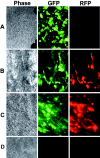Activation of Kaposi's sarcoma-associated herpesvirus lytic gene expression during epithelial differentiation
- PMID: 16227296
- PMCID: PMC1262565
- DOI: 10.1128/JVI.79.21.13769-13777.2005
Activation of Kaposi's sarcoma-associated herpesvirus lytic gene expression during epithelial differentiation
Abstract
The oral cavity has been identified as the major site for the shedding of infectious Kaposi's sarcoma-associated herpesvirus (KSHV). While KSHV DNA is frequently detected in the saliva of KSHV seropositive persons, it does not appear to replicate in salivary glands. Some viruses employ the process of epithelial differentiation for productive viral replication. To test if KSHV utilizes the differentiation of oral epithelium as a mechanism for the activation of lytic replication and virus production, we developed an organotypic raft culture model of epithelium using keratinocytes from human tonsils. This system produced a nonkeratinized stratified squamous oral epithelium in vitro, as demonstrated by the presence of nucleated cells at the apical surface; the expression of involucrin and keratins 6, 13, 14, and 19; and the absence of keratin 1. The activation of KSHV lytic-gene expression was examined in this system using rKSHV.219, a recombinant virus that expresses the green fluorescent protein during latency from the cellular EF-1alpha promoter and the red fluorescent protein (RFP) during lytic replication from the viral early PAN promoter. Infection of keratinocytes with rKSHV.219 resulted in latent infection; however, when these keratinocytes differentiated into a multilayered epithelium, lytic cycle activation of rKSHV.219 occurred, as evidenced by RFP expression, the expression of the late virion protein open reading frame K8.1, and the production of infectious rKSHV.219 at the epithelial surface. These findings demonstrate that KSHV lytic activation occurs as keratinocytes differentiate into a mature epithelium, and it may be responsible for the presence of infectious KSHV in saliva.
Figures







Similar articles
-
Use of the red fluorescent protein as a marker of Kaposi's sarcoma-associated herpesvirus lytic gene expression.Virology. 2004 Aug 1;325(2):225-40. doi: 10.1016/j.virol.2004.03.049. Virology. 2004. PMID: 15246263
-
Activation of Kaposi's sarcoma-associated herpesvirus (human herpesvirus 8) lytic replication by human cytomegalovirus.J Virol. 2001 Feb;75(3):1378-86. doi: 10.1128/JVI.75.3.1378-1386.2001. J Virol. 2001. PMID: 11152511 Free PMC article.
-
Kaposi's sarcoma-associated herpesvirus ORF18 and ORF30 are essential for late gene expression during lytic replication.J Virol. 2014 Oct;88(19):11369-82. doi: 10.1128/JVI.00793-14. Epub 2014 Jul 23. J Virol. 2014. PMID: 25056896 Free PMC article.
-
Kaposi's Sarcoma-Associated Herpesvirus Immediate Early Proteins Trigger FOXQ1 Expression in Oral Epithelial Cells, Engaging in a Novel Lytic Cycle-Sustaining Positive Feedback Loop.J Virol. 2023 Mar 30;97(3):e0169622. doi: 10.1128/jvi.01696-22. Epub 2023 Feb 23. J Virol. 2023. PMID: 36815831 Free PMC article.
-
Lytic cycle switches of oncogenic human gammaherpesviruses.Adv Cancer Res. 2007;97:81-109. doi: 10.1016/S0065-230X(06)97004-3. Adv Cancer Res. 2007. PMID: 17419942 Review.
Cited by
-
Oral manifestations associated with HIV infection.Curr HIV/AIDS Rep. 2008 Feb;5(1):5-12. doi: 10.1007/s11904-008-0002-8. Curr HIV/AIDS Rep. 2008. PMID: 18417029 Review.
-
X box binding protein XBP-1s transactivates the Kaposi's sarcoma-associated herpesvirus (KSHV) ORF50 promoter, linking plasma cell differentiation to KSHV reactivation from latency.J Virol. 2007 Dec;81(24):13578-86. doi: 10.1128/JVI.01663-07. Epub 2007 Oct 10. J Virol. 2007. PMID: 17928342 Free PMC article.
-
Regulation of KSHV Latency and Lytic Reactivation.Viruses. 2020 Sep 17;12(9):1034. doi: 10.3390/v12091034. Viruses. 2020. PMID: 32957532 Free PMC article. Review.
-
Cellular corepressor TLE2 inhibits replication-and-transcription- activator-mediated transactivation and lytic reactivation of Kaposi's sarcoma-associated herpesvirus.J Virol. 2010 Feb;84(4):2047-62. doi: 10.1128/JVI.01984-09. Epub 2009 Nov 25. J Virol. 2010. PMID: 19939918 Free PMC article.
-
Replication in a superficial epithelial cell niche explains the lack of pathogenicity of primate foamy virus infections.J Virol. 2008 Jun;82(12):5981-5. doi: 10.1128/JVI.00367-08. Epub 2008 Apr 9. J Virol. 2008. PMID: 18400853 Free PMC article.
References
-
- Andreoni, M., G. El-Sawaf, G. Rezza, B. Ensoli, E. Nicastri, L. Ventura, L. Ercoli, L. Sarmati, and G. Rocchi. 1999. High seroprevalence of antibodies to human herpesvirus-8 in Egyptian children: evidence of nonsexual transmission. J. Natl. Cancer Inst. 91:465-469. - PubMed
-
- Andreoni, M., L. Sarmati, E. Nicastri, G. El Sawaf, M. El Zalabani, I. Uccella, R. Bugarini, S. G. Parisi, and G. Rezza. 2002. Primary human herpesvirus 8 infection in immunocompetent children. JAMA 287:1295-1300. - PubMed
-
- Asselineau, D., and M. Prunieras. 1984. Reconstruction of ‘simplified’ skin: control of fabrication. Br. J. Dermatol. 111(Suppl. 27):219-222. - PubMed
-
- Bell, E., S. Sher, B. Hull, C. Merrill, S. Rosen, A. Chamson, D. Asselineau, L. Dubertret, B. Coulomb, C. Lapiere, B. Nusgens, and Y. Neveux. 1983. The reconstitution of living skin. J. Investig. Dermatol. 81:2S-10S. - PubMed
Publication types
MeSH terms
Substances
Grants and funding
LinkOut - more resources
Full Text Sources
Research Materials
Miscellaneous

